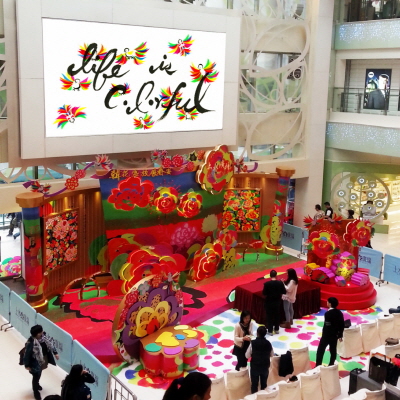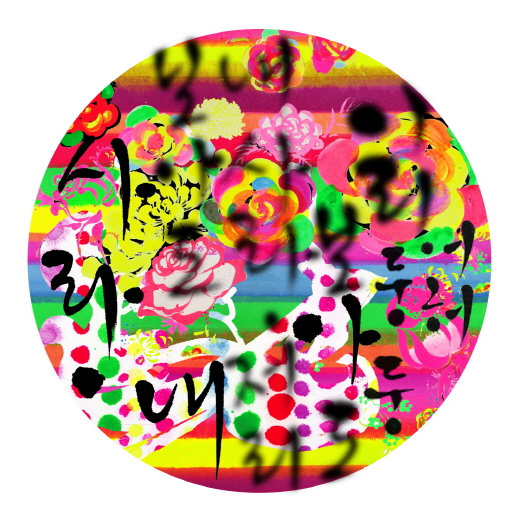
Birth
1970, Seoul
Genre
Painting, Installation, Performance
Homepage
The discourse of synesthesia love
Poetry,calligraphy, and drawing have been one single thing to Hong Ji-yun who grabbed brush at a very young age and they have come to define her ever since. As it istruly one, it could also be plural. Encompassing a variety of interfaces of street,stages, and canvas, Hong Ji-yoon’s foot loose artworks are dubbed as “fusionoriental painting.” This rather exotic restaurant menu-like tagline means nothing more than the fact that “fusion” is her work and life. In the world of profound oriental paintings covered by layers of abstract painting philosophy and theory written in Chinese characters, Hong Ji-yoon’s work is unraveled with her body as if writing a poemand singing might have been breaking taboos at every exhibition.
However, Hong does not fall into the category of a serious woman fighter against hostility and confrontation of the hostility and resistance with the same resistance toward the heterogeneity going against the uniformity. As shown inthe work, she has the strong positive power and optimism as in the sun. Rather than being submissive to the oppression to a person in the institution ofreality, she doesn’t regret her faithfulness to her instinct. If one was truly faithful, there is nothing to be remorseful about. Long before the calligraphy style became a big hit in design trend, Hong Ji-yoon has been writing poetry inbeautiful Korean characters as comfortably and skillfully as could be. Poetry was the start of her work and implant here and there of her work in several shapes. The subjects and title of the work can be shown in her words “from cloud to flower, flower to bird, birdto human, human to love, love to dream…” here everything flows and never fixated to anything. The range offlowers painting the images like flowers and birds, love and dreams expand fromthe traditional rainbow and five Korean traditional colors to naturaltechno-colors to fluorescence artificial lights. Especially the color striped flowers and birds in her latest work embrace the traditional and Pop materialsand colors. The gigantic flower floating on the background of the color stripin
Afew lines free of shape take the flower form while the other vertical orhorizontal lines make the background. The figures and the background constitute the other identical system for a specific segment as did the flowers and wings of the birds.
Usually there are several other panels loosely attached to a single work in colorfulbut not in disarray, compatible to other sketches of her work. Her poems andKorean pop song lyrics like “I should have said I love you,” and enigmatic poetry of Lee Sang are written on the canvas line by line. Hong assures thatarts are the “souls, eyes, star light sand moon lights in the language of future rather than academic or techniques.”This not that easy conclusion drawn by an artist in oriental painting for avery long time is the manifestation of instinctive refusal to academic paternalistic grammar. It is the facial response to the depth, speaking ofwhich we have passed the long tunnel or existence and essence, and the new eraof surfaces have arrived. She started drawing very early and has kept on working on the oriental painting in pursuit of her Ph.D. She started working with avariety of other groups and networked through the Yonsei Digital Hollywoodwhich was new back in 2001.
It was woman’s body that internalized the paper, pen, and ink. The woman is madeof love and the paradoxical love stories.《Rediscovery of Korean Painting》was first exhibited atSeongnam Art Center in Gyunggido in the year 2011.
Itslightly reminds me of Baudelaire, another modern poet of synesthesia, who was assured of the uniformity of prostitution, love, and art in similar titles andforms. The flowers in full bloom against black background of the ink wash painting on Korean paper are splendid in dark shadows of death. The colors about to be swallowed by the darkness becomelights at a moment. Only the flower petals or lines or brush stroke have theinstant cohesiveness. Or it could be the moment of deconstruction that it canbe scattered into the universe. It is floated without taking its roots to anywhere else. The metaphor of love ingrained in the full bloomed flowers andthe birds flapping its wings overlaps with the metaphor of death symbolizedinto black colors or paper flowers. The flower decorated bridal palanquin orthe flowers decorating bier share the symbols of love and death. In HongJi-yoon’s works, the woman meeting a man is as lethal as the meeting of loveand death. The beautiful characters written on letter, paintings, LCD monitors,and embroidery on a blanket are covered with the discourse of love or death. Thecombination has been the universal theme of all the poetry and songs indisregard of the time and country.
“Those many blossoms would bloom and wither(Hong Ji-yoon)” and “the flowering trees cannot go to the trees they want (Lee Sang).” Here comes the strong moments of love and dramatic incongruity. As in the title of Hong’s poem “She, Beautiful Flowers”, flowers are women for Hong Ji-yoon. “Flowers indicate the beauty, women, and the great joy over life.” It “paradoxically reveals the joyous moments and fierce competition for survival in fettered lives and history.” The flowers, the main image of Hong’s works, encompasses from the basic human hope, anger, love, and joy to birth and death of lives and universe, female artist Hong Ji-yoon’s flowers have its specified images. It is the discourse of lovethat responds to the universe of flowers full of luxurious colors and energies.It is not simply the representation or expression of love with flowers orpoetry. Even in the work where historical figure like Keum Hong and Lee Sangappear, it is not the issues of expression or representations. Although thework is filled with symbols expressing strong love, it is not the specified object that the symbols stand for. The art work in itself for female artist isthe discourse of love.
In “Histoires d’amour (Tales of Love),” Julia Kristeva says love is writing to a woman. Women who fall in love write things. Writing something down therefore is an ordeal of a discourse as if writing about love. Project could be ordeal, challenge, despair, and rejoice like love. The language of loveis not straightforward it is metaphorical. Love is like the ordeal of taking acommunications test. For Hong Ji-yoon, love is something that has been talked about. Therefore, she writes down things whenever she can. In her works wherethe fantasy of love materializes, like excessive eloquence of hysteria in thedense lines can be thought of as another symptom of aphasia, or impairment oflanguage ability. The discourse of love, which might have been addressed to anaudience, is read by an average audience. It looks as uncertain and metaphorically compressed as is the poetry. According to Krosteva, metaphor is convergence. Unlike comparison where two terms continuously maintains the other’s territories, metaphor checks the duality without excluding any one of the two parts. Metaphor becomes transformation or synesthesia,and the eternalized meanings of the metaphor changes into uniquely sensual andsultry enjoyment.
Scattered ego can only stand with metaphor and starts writing. For Hong, flowers are moreof a metaphor than fixated symbols. It contains the experiences of love asdynamics of crisis and subjective renovation in discourses, and the characteristics of metaphor as linguistically relevant elements. Flowers andpoetry are the elements that cannot be represented as metaphors and becomes thebasis for signs. Hong’s synesthesia works stand in between the signs. The substructure of writing?according to Kristeva is in the state of love?is synesthesia. The exchange is another contagion or compression. Synesthesia is the metaphor inside the language in volatility, or that does not exist yet, orit no longer exists. Femininity, the most critical element in Hong’s work hasthe altruism that cannot be expressed like the metaphor of love. The Eros inwoman is as active as libido of death. In a symbolic way the a woman’s desireare thought to be as connected with the umbilical cord just as death is connected to the source of matrix, for a life is well aware of the power to destroy life. The cycle of woman and life in Hong Ji-yoon’s work contains the link of love and death.
LEE Sunyoung (Art Critic)



























